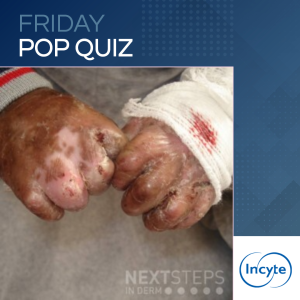
The correct answer is E. Recessive dystrophic epidermolysis bullosa.
The picture is shown is know as “mitten hands” and is diagnostic for the autosomal recessive form of dystrophic epidermolysis bullosa (RDEB).This is a classic kodachrome for recessive dystrophic EB. It may present with severe blistering (generalized severe RDEB) or mild disease (generalized intermediate RDEB). Generalized severe blistering is more common and involves large areas of skin and mucous membranes. Blisters heal but with scarring and deformity causing limited movement as fingers and toes may be fused together (mitten hands as demonstrated in this photo). Complications such as infection, malnutrition and dehydration may cause death in infancy. Those that survive are at great risk of developing potentially dangerous squamous cell carcinoma within chronic EB wounds. SCC look and behave differently in EB from in unaffected individuals. They are found on covered sites and grow rapidly. They present as ulcerated or keratotic nodules and plaques.
Junctional EB herlitz can have mutations in LAMA3, LAMB3, or LAMC2. It is autosomal recessive inheritance. It typically presents with generalied blisters that heal without scarring. Sites include the buttocks, peri-oral area, and pinnae of the ears. Classic kodachrome findings include granulation tissue of nail beds and perioral granulation tissue may develop beyond 6 months of age. Death usually occurs within the first few years of life from respiratory failure or septicemia. Junctional EB non-herlitz type can have mutations in LAMA3, LAMB3, LAMC2, and COL17A1. It is aso autosomal recesssive inheritance. It presents with generalized blisters and oral involvement common in neonatal period, but improves as child ages. Patients typically survive till adulthood. Dowling-Meara form of epidermolysis bullous simplex typically has mutations in keratin 5 and 14 and is autosomal dominant inheritance. It has mutations in keratin 5 and 14. It presents with generalized severe blistering at birth or within the first few weeks of life. After first few months of life, bullae take on characteristic clustered herpetiformis appearance (crown of jewels). It may rarely heal with some scarring and milia but would not show mitten hand deformity. Dominant dystrophic epidermolysis bullosa is autosomal dominant inheritance with mutations in COL7A1. It presents with generalized bullae, most prominent overlying extensor joints. It tends to improve over time and heals with atrophic scarring and milia. Patients characteristically demonstrate nail dystrophy. It would also not demonstrate a mitten hands deformity.
References: OMIM – Online Mendelian Inheritance in Man (search term Epidermolysis bullosa)
Epidermolysis Bullosa Simplex – GeneTests GeneReviews
Dystrophic Epidermolysis Bullosa – GeneTests GeneReviews
Dermatologic Clinics Volume 28, Issue 1, Pages 1-196 (January 2010) Epidermolysis Bullosa: Part I – Pathogenesis and Clinical Features
Dermatologic Clinics Volume 28, Issue 2, Pages 197-452 (April 2010) Epidermolysis Bullosa: Part II – Diagnosis and Management
El Hachem M, Zambruno G, Bourdon-Lanoy E, Ciasulli A, Buisson C, Hadj-Rabia S, Diociaiuti A, Gouveia CF, Hernández-Martín A, de Lucas Laguna R, Dolenc-Voljč M, Tadini G, Salvatori G, De Ranieri C, Leclerc-Mercier S, Bodemer C. Multicentre consensus recommendations for skin care in inherited epidermolysis bullosa. Orphanet J Rare Dis. 2014 May 20;9:76. doi: 10.1186/1750-1172-9-76. Review. PubMed PMID: 24884811; PubMed Central PMCID: PMC4110526.
Fine JD, Bruckner-Tuderman L, Eady RA, Bauer EA, Bauer JW, Has C, Heagerty A, Hintner H, Hovnanian A, Jonkman MF, Leigh I, Marinkovich MP, Martinez AE, McGrath JA, Mellerio JE, Moss C, Murrell DF, Shimizu H, Uitto J, Woodley D, Zambruno G. Inherited epidermolysis bullosa: updated recommendations on diagnosis and classification. J Am Acad Dermatol. 2014 Jun;70(6):1103-26. doi: 10.1016/j.jaad.2014.01.903. Epub 2014 Mar 29. Review. PubMed PMID: 24690439..
